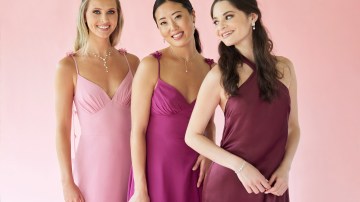In this week’s luxury briefing, a look at how Coach is gaming the “charm economy.” Plus, Prada is the most impersonated brand online, and Arc’teryx is betting on luxury retail amid slowed growth. And the latest Glossy podcast features a sneaker roundtable with executives from Culture Media and StockX. For tips or comments, email me at zofia@glossy.co
Bag charms started as playful styling flourishes when they emerged onto the scene last year, but at Coach, they’ve become a serious business driver. In stores, they’re front and center, hooked onto mannequins and placed near checkout, encouraging buyers to return and personalize their purchase. The result: faster repeat purchases and a growing revenue stream built on these $50 add-ons.
“We’re not waiting six months for a return purchase anymore; it now happens in just three weeks,” said Coach CEO Todd Kahn in an interview with Glossy. “A customer might buy a bag, then come back a few weeks later for a charm, a strap or a piece of jewelry. It’s the charm economy, and the economics of that are really compelling.”
The trend has Coach’s growing Gen-Z customer base engaging with the brand more frequently and expressing themselves through affordable upgrades, which are priced between $50-$95. Kahn confirmed they’ve already brought in millions for the brand.
“It’s not just an accessory,” he said. “It’s a way to show individuality.”
According to Kahn, Coach recently sold a cherry charm that “became like a collector’s item.”
“People were asking for it by name. We couldn’t keep it in stock,” he said.
In the company’s 2025 fiscal year, Coach reported $5.9 billion in revenue, marking its strongest year yet. The brand added 4.6 million new customers in North America alone, 70% of whom were Gen Z or millennials. While core bag styles like the Tabby and the Brooklyn remain foundational, the company sees personalization and add-ons as key to building ongoing relationships with younger shoppers.
“We’re seeing a younger customer — even someone who’s just entered the workforce — buy a bag and come back not long after because they want to personalize it,” said Kahn. “It becomes part of their story.”
This isn’t just a passing trend. Last September, Coach svp of global visual experience, Gio Zaccariello, told Glossy that personalization is now central to the brand’s customer experience. So far, the brand is doing charms for bags and sneakers, and it’s not ruling out other categories. “It’s a way for consumers to connect emotionally with their items, making them feel unique,” Zaccariello said.
Coach has adapted its merchandising strategy accordingly. Charms are prominently displayed in stores, near checkout and at eye level, and styled online to encourage layering and customization. According to Kahn, some seasonal charm drops now sell out within days.
The in-store strategy extends beyond merchandising. Store associates are trained to introduce personalization options as part of the bag-selling experience. “Our store associates are storytellers,” said Kahn. “They help the customer see the full picture — not just the bag, but how to make it theirs.” This soft-sell approach makes add-ons feel like a natural extension of the purchase, not just an extra.
Even so, the economic impact is real. “We’re a $5 billion brand, and I need big $100 million ideas,” said Kahn. “I like where charms sit in that equation.”
CNBC reported that, in 2024, footwear brand Crocs generated $271 million from Jibbitz charms — just over 8% of its total revenue — spotlighting the strong commercial potential of personalization items.
Smaller brands are seeing similar behavior. At Parker Thatch, a direct-to-consumer accessories label known for personalization, creative director Joyce Lee — formerly of Madewell — said the customer also seeks ways to modify the bag right away. “Even if the bag already has a strap, she’ll ask, ‘What else can I put on it?’” said Lee. “We’ve found that personalization pieces are almost always bought either with the bag or shortly after.”
One of Parker Thatch’s bestselling items is its “mystery buddy” pouch, a blind-box collectible — usually a charm — priced at $98. “It resonates across generations,” said Lee. “We see moms buying them for themselves and then gifting one to their daughters. It creates a kind of joyful ritual.”
That joy is translating into long-term strategy. In a cautious economic climate, brands are looking for ways to increase customer frequency without relying on promotions or markdowns.
“We’re not just selling another bag,” said Coach’s Kahn. “We’re building an ecosystem where customers can continually refresh and reimagine what they already own.”
Luxury brands have taken note. Hermès’s Rodeo Pegase charm, priced at £530, has become a resale favorite and perennial waitlist item. Gucci, Prada, and Loewe have also launched dedicated charm collections over the past year.
The current charm boom can be traced back to early 2024, when Pop Mart’s mischievous Labubu character went viral on TikTok and Instagram. The plush toy, often clipped to designer bags, helped fuel the explosion of charm content online. Labubu quickly became a cultural marker, spotted on everyone from influencers to celebrities, like Lisa from K-pop band Blackpink — the singer wore a custom Labubu on her belt complete with a Labubu costume at the group’s London concert just last weekend.
But unlike Labubu’s rare collector styles, Coach and Parker Thatch are positioning charms as accessible, modular upgrades. “It’s about allowing the customer to tell their own story,” said Lee. “We’re not chasing newness for its own sake. We’re giving her tools to personalize and play.”
Kahn agrees that the category is delivering more than trend value. “Low return rates, strong margins, high emotional value — the economics are very compelling,” he said.
Stat of the week
Prada was the most impersonated luxury brand online between July 2024 and July 2025, with scammers registering 2,259 fake websites using its name, according to newly surfaced exclusive domain data from digital risk protection company BrandShield. It was followed closely by Gucci, with 2,112 fake websites, and Louis Vuitton, with 305.
Earnings
- Amer Sports, parent company of Arc’teryx, Salomon and Wilson, reported second-quarter 2025 earnings on Tuesday. In the earnings, it was revealed that Arc’teryx is quietly positioning itself as a luxury outdoor brand, opening a store at the Peninsula Hotel in Beijing and planning a flagship on Fifth Avenue’s Rockefeller Center. James Zheng, CEO of Amer Sports, said “the store represents our most elevated expansion of the brand designed for top-tier luxury shopping experiences.” Amer Sports disclosed Technical Apparel revenue of $509 million, up 23% year over year, driven by full‑price DTC sales.
Executive moves
- Womenswear brand Veronica Beard has appointed Monica Freedman as chief direct-to-consumer officer, tapping the former Khy and Alo Yoga executive to lead global e-commerce and retail as the brand deepens its DTC focus and builds a CRM-driven, omnichannel experience for its customers.
News to know
- Louis Vuitton is entering the color cosmetics category with the launch of La Beauté, a luxury makeup line led by Pat McGrath and debuting in China this week. It brings 55 lipsticks, refillable packaging and a red-sheathed SoHo pop-up to life as the brand redefines beauty through the lens of travel, craftsmanship and bold, wearable color.
- Topshop and Topman will return to U.K. physical retail on August 28 with an exclusive in-store residency at Liberty London, located near their former Oxford Street flagship. The launch will feature a curated edit of tailoring, denim, dresses and essentials, showcased through a full atrium takeover inside Liberty’s historic Tudor building.
- The U.K.’s advertising watchdog is cracking down on a growing wave of fashion ads featuring “unhealthily thin-looking” models, urging brands like Zara and M&S to rethink imagery that glamorizes extreme body types amid a wider return to ‘90s-era thinness.
- The global smart textiles market is set to more than double by 2030, reaching $5.56 billion, as medical, military and athleisure industries drive demand for sensor-embedded garments that track everything from heart rate to hydration. Asia leads the growth, thanks to its manufacturing strength and rising health-tech adoption.
Listen in
On this week’s Glossy Podcast, senior fashion reporter Danny Parisi and editor-in-chief Jill Manoff unpack the latest in fashion, including the delayed China tariffs, the new duties on Swiss imports that are disrupting luxury, the sale of HanesBrands to Gildan and the backlash over Adidas x Willy Chavarria’s Oaxacan Slip-On. Later, international reporter Zofia Zwieglinska joins for a roundtable with sneaker experts, including Culture Media’s Alex Lotier, Macy’s Noah Thomas and StockX’s Brendan Dunne. They discuss the evolving sneaker market, where brands like On and Hoka are edging out giants like Nike and experimental styles are reshaping demand. Listen here.
Read on Glossy
Why jewelry brands are betting bigger on sports. How Coach is navigating the changing retail landscape post de minimis. How brands are targeting Gen Z for back-to-school.




